NCERT Solutions | Class 12 Maths Chapter 4 | Determinants

CBSE Solutions | Maths Class 12
Check the below NCERT Solutions for Class 12 Maths Chapter 4 Determinants Pdf free download. NCERT Solutions Class 12 Maths were prepared based on the latest exam pattern. We have Provided Determinants Class 12 Maths NCERT Solutions to help students understand the concept very well.
NCERT | Class 12 Maths
| Book: | National Council of Educational Research and Training (NCERT) |
|---|---|
| Board: | Central Board of Secondary Education (CBSE) |
| Class: | 12th |
| Subject: | Maths |
| Chapter: | 4 |
| Chapters Name: | Determinants |
| Medium: | English |
Determinants | Class 12 Maths | NCERT Books Solutions
NCERT Solutions for Class 12 Maths Chapter 4 Determinants Ex 4.1
Ex 4.1 Class 12 Maths Question 1.
Evaluate the following determinant:
\(\begin{vmatrix} 2 & 4 \\ -5 & -1 \end{vmatrix}\)
Solution.
\(\begin{vmatrix} 2 & 4 \\ -5 & -1 \end{vmatrix}\)
= 2x(-1)-(-5)x(4)
=-2+20
=18
Ex 4.1 Class 12 Maths Question 2.
(i) \(\begin{vmatrix} cos\theta & \quad -sin\theta \\ sin\theta & \quad cos\theta \end{vmatrix}\)
(ii) \(\begin{vmatrix} { x }^{ 2 }-x+1 & x-1 \\ x+1 & x+1 \end{vmatrix}\)
Solution.
(i) \(\begin{vmatrix} cos\theta & \quad -sin\theta \\ sin\theta & \quad cos\theta \end{vmatrix}\)
= cosθ cosθ – (sinθ)(-sinθ)
= cos²θ + sin²θ
= 1
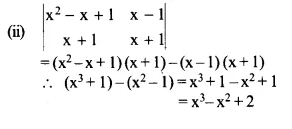
Ex 4.1 Class 12 Maths Question 3.
If \(A=\begin{bmatrix} 1 & 2 \\ 4 & 2 \end{bmatrix}\) then show that |2A|=|4A|
Solution.
\(A=\begin{bmatrix} 1 & 2 \\ 4 & 2 \end{bmatrix}\)
=> \(2A=\begin{bmatrix} 2 & 4 \\ 8 & 4 \end{bmatrix}\)
L.H.S = |2A|
= \(2A=\begin{bmatrix} 2 & 4 \\ 8 & 4 \end{bmatrix}\)
= – 24

Ex 4.1 Class 12 Maths Question 4.
\(A=\left[ \begin{matrix} 1 & 0 & 1 \\ 0 & 1 & 2 \\ 0 & 0 & 4 \end{matrix} \right] \) , then show that |3A| = 27|A|
Solution.
3A = \(3\left[ \begin{matrix} 1 & 0 & 1 \\ 0 & 1 & 2 \\ 0 & 0 & 4 \end{matrix} \right] \)
= \(3\left[ \begin{matrix} 3 & 0 & 3 \\ 0 & 3 & 6 \\ 0 & 0 & 12 \end{matrix} \right] \)
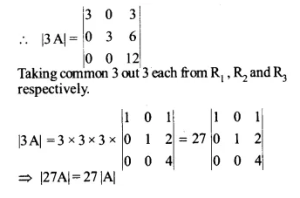
Ex 4.1 Class 12 Maths Question 5.
Evaluate the following determinant:
(i) \(\left| \begin{matrix} 3 & -1 & -2 \\ 0 & 0 & -1 \\ 3 & -5 & 0 \end{matrix} \right| \)
(ii) \(\left| \begin{matrix} 3 & -4 & 5 \\ 1 & 1 & -2 \\ 2 & 3 & 1 \end{matrix} \right| \)
(iii) \(\left| \begin{matrix} 0 & 1 & 2 \\ -1 & 0 & -3 \\ -2 & 3 & 0 \end{matrix} \right| \)
(iv) \(\left| \begin{matrix} 2 & -1 & -2 \\ 0 & 2 & -1 \\ 3 & -5 & 0 \end{matrix} \right| \)
Solution.
(i) \(\left| \begin{matrix} 3 & -1 & -2 \\ 0 & 0 & -1 \\ 3 & -5 & 0 \end{matrix} \right| \)
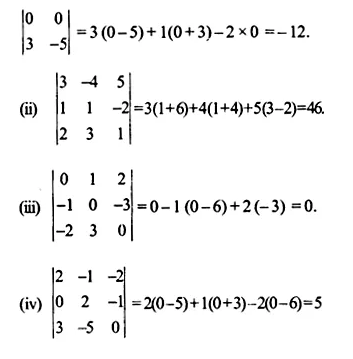 >
>
Ex 4.1 Class 12 Maths Question 6.
If \(\left[ \begin{matrix} 1 & 1 & -2 \\ 2 & 1 & -3 \\ 5 & 4 & -9 \end{matrix} \right] \), find |A|
Solution.
|A| = \(\left[ \begin{matrix} 1 & 1 & -2 \\ 2 & 1 & -3 \\ 5 & 4 & -9 \end{matrix} \right] \)
= 1(-9+12)-1(-18+15)-2(8-5)
= 0
Ex 4.1 Class 12 Maths Question 7.
Find the values of x, if
(i) \(\begin{vmatrix} 2 & 4 \\ 5 & 1 \end{vmatrix}=\begin{vmatrix} 2x & 4 \\ 6 & x \end{vmatrix}\)
(ii)\(\begin{vmatrix} 2 & 3 \\ 4 & 5 \end{vmatrix}=\begin{vmatrix} x & 3 \\ 2x & 5 \end{vmatrix}\)
Solution.
(i) \(\begin{vmatrix} 2 & 4 \\ 5 & 1 \end{vmatrix}=\begin{vmatrix} 2x & 4 \\ 6 & x \end{vmatrix}\)
=> 2 – 20 = 2x² – 24
=> x² = 3
=> x = ±√3
(ii)\(\begin{vmatrix} 2 & 3 \\ 4 & 5 \end{vmatrix}=\begin{vmatrix} x & 3 \\ 2x & 5 \end{vmatrix}\)
or
2 × 5 – 4 × 3 = 5 × x – 2x × 3
=>x = 2
Ex 4.1 Class 12 Maths Question 8.
If \(\begin{vmatrix} x & 2 \\ 18 & x \end{vmatrix}=\begin{vmatrix} 6 & 2 \\ 18 & 6 \end{vmatrix}\), then x is equal to
(a) 6
(b) +6
(c) -6
(d) 0
Solution.
(b) \(\begin{vmatrix} x & 2 \\ 18 & x \end{vmatrix}=\begin{vmatrix} 6 & 2 \\ 18 & 6 \end{vmatrix}\)
=> x² – 36 = 36 – 36
=> x² = 36
=> x = ± 6
NCERT Solutions for Class 12 Maths Chapter 4 Determinants Ex 4.2
Using the property of determinants and without expanding in Q 1 to 5, prove that
<Ex 4.2 Class 12 Maths Question 1.
\(\left| \begin{matrix} x & a & x+a \\ y & b & y+b \\ z & c & z+c \end{matrix} \right| =0\)
Solution.
L.H.S = \(\left| \begin{matrix} x & a & x \\ y & b & y \\ z & c & z \end{matrix} \right| +\left| \begin{matrix} x & a & a \\ y & b & b \\ z & c & c \end{matrix} \right| \)
(C1 = C3 and C2 = C3)
= 0 + 0
= 0
= R.H.S
Ex 4.2 Class 12 Maths Question 2.
\(\left| \begin{matrix} a-b & b-c & c-a \\ b-c & c-a & a-b \\ c-a & a-b & b-c \end{matrix} \right| =0\)
Solution.
L.H.S = \(\left| \begin{matrix} a-b & b-c & c-a \\ b-c & c-a & a-b \\ c-a & a-b & b-c \end{matrix} \right| =0\)
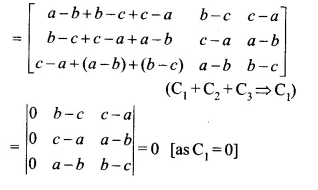
Ex 4.2 Class 12 Maths Question 3.
\(\left| \begin{matrix} 2 & 7 & 65 \\ 3 & 8 & 75 \\ 5 & 9 & 86 \end{matrix} \right| =0\)
Solution.
\(\left| \begin{matrix} 2 & 7 & 65 \\ 3 & 8 & 75 \\ 5 & 9 & 86 \end{matrix} \right| =\left| \begin{matrix} 2 & 7 & 0 \\ 3 & 8 & 0 \\ 5 & 9 & 0 \end{matrix} \right| \)
\({ C }_{ 3 }\rightarrow { C }_{ 3 }-{ C }_{ 1 }-{ 9C }_{ 2 }=0\)
Ex 4.2 Class 12 Maths Question 4.
\(\left| \begin{matrix} 1 & bc & a(b+c) \\ 1 & ca & b(c+a) \\ 1 & ab & c(a+b) \end{matrix} \right| =0\)
Solution.
L.H.S = \(\left| \begin{matrix} 1 & bc & a(b+c) \\ 1 & ca & b(c+a) \\ 1 & ab & c(a+b) \end{matrix} \right| \)
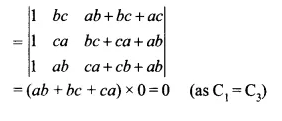
Ex 4.2 Class 12 Maths Question 5.
\(\left| \begin{matrix} b+c & q+r & y+z \\ c+a & r+p & z+x \\ a+b & p+q & x+y \end{matrix} \right| =2\left| \begin{matrix} a & p & x \\ b & q & y \\ c & r & z \end{matrix} \right| \)
Solution.
L.H.S = ∆ = \(\left| \begin{matrix} b+c & q+r & y+z \\ c+a & r+p & z+x \\ a+b & p+q & x+y \end{matrix} \right| \)
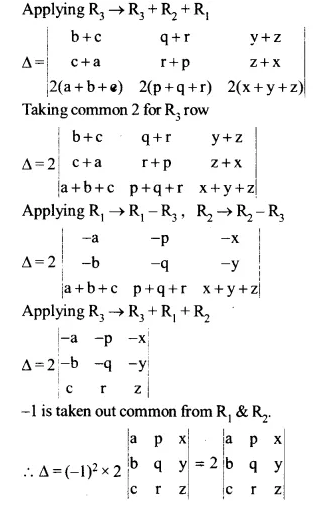
By using properties of determinants in Q 6 to 14, show that
Ex 4.2 Class 12 Maths Question 6.
\(\left| \begin{matrix} 0 & a & -b \\ -a & 0 & -c \\ b & c & 0 \end{matrix} \right| =0\)
Solution.
L.H.S = ∆ = \(\left| \begin{matrix} 0 & a & -b \\ -a & 0 & -c \\ b & c & 0 \end{matrix} \right| \) …(i)
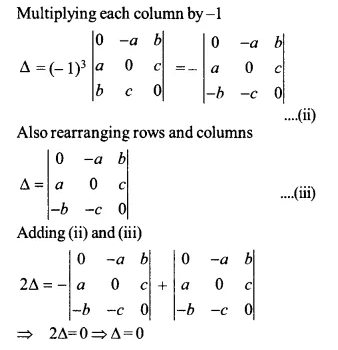
Ex 4.2 Class 12 Maths Question 7.
\(\left| \begin{matrix} { -a }^{ 2 } & ab & ac \\ ba & { -b }^{ 2 } & bc \\ ac & cb & { -c }^{ 2 } \end{matrix} \right| ={ 4a }^{ 2 }{ b }^{ 2 }{ c }^{ 2 }\)
Solution.
L.H.S = \(\left| \begin{matrix} { -a }^{ 2 } & ab & ac \\ ba & { -b }^{ 2 } & bc \\ ac & cb & { -c }^{ 2 } \end{matrix} \right| \)
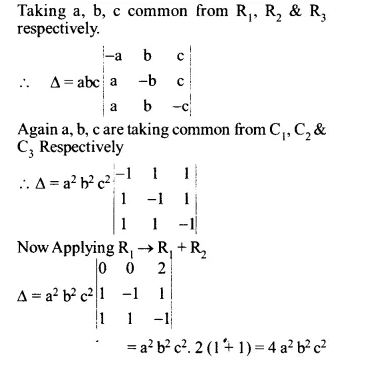
Ex 4.2 Class 12 Maths Question 8.
(a) \(\left| \begin{matrix} 1 & a & { a }^{ 2 } \\ 1 & b & { b }^{ 2 } \\ 1 & c & { c }^{ 2 } \end{matrix} \right| =(a-b)(b-c)(c-a)\)
(b) \(\left| \begin{matrix} 1 & 1 & 1 \\ a & b & c \\ { a }^{ 3 } & { b }^{ 3 } & { c }^{ 3 } \end{matrix} \right| =(a-b)(b-c)(c-a)(a+b+c)\)
Solution.
(a) L.H.S = \(\left| \begin{matrix} 1 & a & { a }^{ 2 } \\ 1 & b & { b }^{ 2 } \\ 1 & c & { c }^{ 2 } \end{matrix} \right| \)
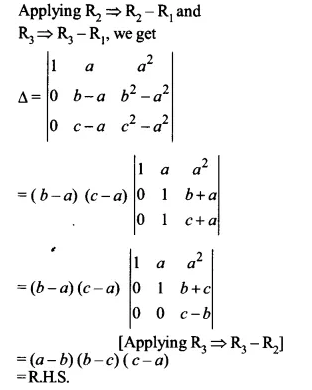
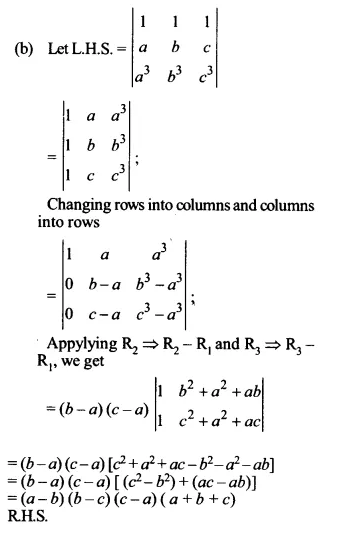
Ex 4.2 Class 12 Maths Question 9.
\(\left| \begin{matrix} x & x^{ 2 } & yx \\ y & { y }^{ 2 } & zx \\ z & { z }^{ 2 } & xy \end{matrix} \right| =(x-y)(y-z)(z-x)(xy+yz+zx)\)
Solution.
Let ∆ = \(\left| \begin{matrix} x & x^{ 2 } & yx \\ y & { y }^{ 2 } & zx \\ z & { z }^{ 2 } & xy \end{matrix} \right|\)
Applying R1–>R1 – R2, R2–>R2 – R3
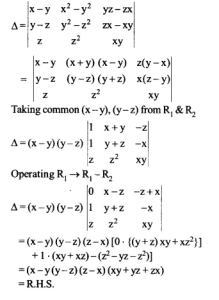
Ex 4.2 Class 12 Maths Question 10.
(a) \(\left| \begin{matrix} x+4 & 2x & 2x \\ 2x & x+4 & 2x \\ 2x & 2x & x+4 \end{matrix} \right| =(5x+4){ (4-x) }^{ 2 }\)
(b) \(\left| \begin{matrix} y+x & y & y \\ y & y+k & y \\ y & y & y+k \end{matrix} \right| ={ k }^{ 2 }(3y+k) \)
Solution.
(a) L.H.S = \(\left| \begin{matrix} x+4 & 2x & 2x \\ 2x & x+4 & 2x \\ 2x & 2x & x+4 \end{matrix} \right|
\)
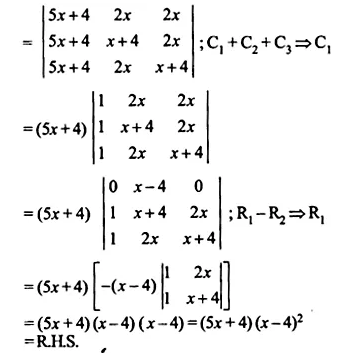
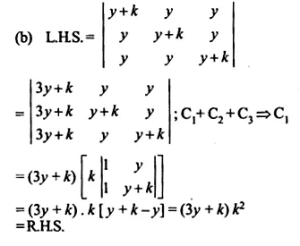
Ex 4.2 Class 12 Maths Question 11.
(a) \(\left| \begin{matrix} a-b-c & \quad 2a & \quad 2a \\ 2b & \quad b-c-a & \quad 2b \\ 2c & 2c & \quad c-a-b \end{matrix} \right| ={ (a+b+c) }^{ 3 } \)
(b) \(\left| \begin{matrix} x+y+2z & \quad z & \quad z \\ x & \quad y+z+2x & \quad x \\ y & y & \quad z+x+2y \end{matrix} \right| ={ 2(x+y+z) }^{ 3 } \)
Solution.
(a) L.H.S = \(\left| \begin{matrix} a-b-c & \quad 2a & \quad 2a \\ 2b & \quad b-c-a & \quad 2b \\ 2c & 2c & \quad c-a-b \end{matrix} \right| \)
= \(\left( a+b+c \right) \left| \begin{matrix} 1 & \quad 1 & \quad 1 \\ 2b & \quad b-c-a & \quad 2b \\ 2c & \quad 2c & \quad c-a-b \end{matrix} \right| \)
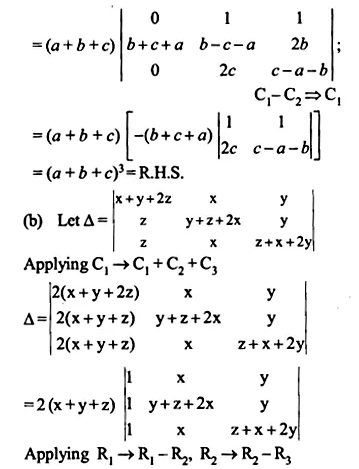
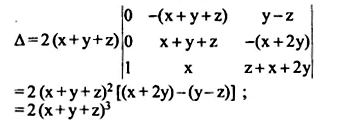
Ex 4.2 Class 12 Maths Question 12.
\(\left| \begin{matrix} 1 & \quad x & { \quad x }^{ 2 } \\ { x }^{ 2 } & \quad 1 & x \\ x & { \quad x }^{ 2 } & 1 \end{matrix} \right| ={ { (1-x }^{ 3 }) }^{ 2 } \)
Solution.
L.H.S = \(\left| \begin{matrix} 1 & \quad x & { \quad x }^{ 2 } \\ { x }^{ 2 } & \quad 1 & x \\ x & { \quad x }^{ 2 } & 1 \end{matrix} \right| \)
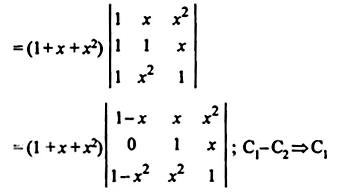
Ex 4.2 Class 12 Maths Question 13.
\(\left| \begin{matrix} 1+{ a }^{ 2 }-{ b }^{ 2 } & \quad 2ab & \quad -2b \\ 2ab & \quad 1-{ a }^{ 2 }+{ b }^{ 2 } & \quad 2a \\ 2b & \quad -2a & \quad 1-{ a }^{ 2 }+{ b }^{ 2 } \end{matrix} \right| ={ (1+{ a }^{ 2 }+{ b }^{ 2 }) }^{ 3 } \)
Solution.
L.H.S = \(\left| \begin{matrix} 1+{ a }^{ 2 }-{ b }^{ 2 } & \quad 2ab & \quad -2b \\ 2ab & \quad 1-{ a }^{ 2 }+{ b }^{ 2 } & \quad 2a \\ 2b & \quad -2a & \quad 1-{ a }^{ 2 }+{ b }^{ 2 } \end{matrix} \right| \)
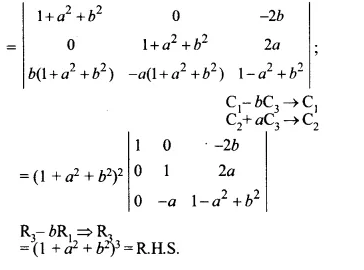
Ex 4.2 Class 12 Maths Question 14.
\(\left| \begin{matrix} { a }^{ 2 }+1 & \quad ab & \quad ac \\ ab\quad & \quad b^{ 2 }+1 & \quad bc \\ ca\quad & \quad cb & \quad { c }^{ 2 }+1 \end{matrix} \right| =1+{ a }^{ 2 }+{ b }^{ 2 }+{ c }^{ 2 } \)
Solution.
Let ∆ = \(\left| \begin{matrix} { a }^{ 2 }+1 & \quad ab & \quad ac \\ ab\quad & \quad b^{ 2 }+1 & \quad bc \\ ca\quad & \quad cb & \quad { c }^{ 2 }+1 \end{matrix} \right| \)
\(\left| \begin{matrix} { a }^{ 2 }+1 & \quad ab+0 & \quad ac+0 \\ ab+0\quad & \quad b^{ 2 }+1 & \quad bc+0 \\ ca+0\quad & \quad cb+0 & \quad { c }^{ 2 }+1 \end{matrix} \right| \)
This may be expressed as the sum of 8 determinants
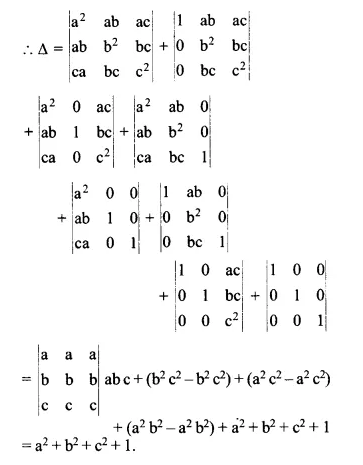
Ex 4.2 Class 12 Maths Question 15.
If A be a square matrix of order 3×3, then | kA | is equal to
(a) k|A|
(b) k² |A|
(c) k³ |A|
(d) 3k|A|
Solution.
Option (c) is correct.
Ex 4.2 Class 12 Maths Question 16.
Which of the following is correct:
(a) Determinant is a square matrix
(b) Determinant is a number associated to a matrix
(c) Determinant is a number associated to a square matrix
(d) None of these
Solution.
Option (c) is correct
NCERT Solutions for Class 12 Maths Chapter 4 Determinants Ex 4.3
Ex 4.3 Class 12 Maths Question 1.
Find the area of the triangle with vertices at the point given in each of the following:
(i) (1,0), (6,0) (4,3)
(ii) (2,7), (1,1), (10,8)
(iii) (-2,-3), (3,2), (-1,-8)
Solution.
(i) Area of triangle = \(\frac { 1 }{ 2 } \left| \begin{matrix} 1\quad & 0 & \quad 1 \\ 6\quad & 0 & \quad 1 \\ 4\quad & 3 & \quad 1 \end{matrix} \right| \)
= \(\\ \frac { 1 }{ 2 } \) [1(0-3)+1(18-0)]
= 7.5 sq units
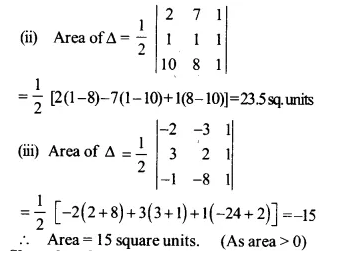
Ex 4.3 Class 12 Maths Question 2.
Show that the points A (a, b + c), B (b, c + a) C (c, a+b) are collinear.
Solution.
The vertices of ∆ABC are A (a, b + c), B (b, c + a) and C (c, a + b)

Ex 4.3 Class 12 Maths Question 3.
Find the value of k if area of triangle is 4 square units and vertices are
(i) (k, 0), (4,0), (0,2)
(ii) (-2,0), (0,4), (0, k).
Solution.
(i) Area of ∆ = 4 (Given)
\(\frac { 1 }{ 2 } \left| \begin{matrix} k\quad & 0 & \quad 1 \\ 4\quad & 0 & \quad 1 \\ 0\quad & 2 & \quad 1 \end{matrix} \right| \)
= \(\\ \frac { 1 }{ 2 } \) [-2k+8]
= -k+4
Case (a): -k + 4 = 4 ==> k = 0
Case(b): -k + 4 = -4 ==> k = 8
Hence, k = 0,8
(ii) The area of the triangle whose vertices are (-2,0), (0,4), (0, k)
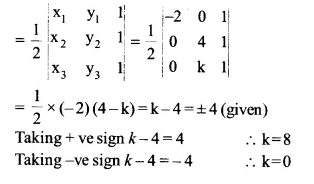
Ex 4.3 Class 12 Maths Question 4.
(i) Find the equation of line joining (1, 2) and (3,6) using determinants.
(ii) Find the equation of line joining (3,1), (9,3) using determinants.
Solution.
(i) Given: Points (1,2), (3,6)
Equation of the line is
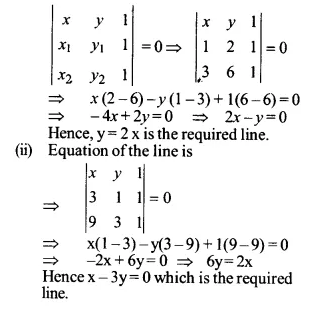
Ex 4.3 Class 12 Maths Question 5.
If area of triangle is 35 sq. units with vertices (2, – 6), (5,4) and (k, 4). Then k is
(a) 12
(b) – 2
(c) -12,-2
(d) 12,-2
Solution.
(d) Area of ∆ = \(\frac { 1 }{ 2 } \left| \begin{matrix} 2\quad & -6 & \quad 1 \\ 5\quad & 4 & \quad 1 \\ k\quad & 4 & \quad 1 \end{matrix} \right| \)
= \(\\ \frac { 1 }{ 2 } \) [50 – 10k] = 25 – 5k
∴ 25-5k = 35 or 25-5k = -35
-5k = 10 or 5k = 60
=> k = -2 or k = 12
NCERT Solutions for Class 12 Maths Chapter 4 Determinants Ex 4.4
Ex 4.4 Class 12 Maths Question 1.
Write the minors and cofactors of the elements of following determinants:
(i) \(\begin{vmatrix} 2 & -4 \\ 0 & 3 \end{vmatrix}\)
(ii) \(\begin{vmatrix} a & c \\ b & d \end{vmatrix}\)
Solution.
(i) Let A = \(\begin{vmatrix} 2 & -4 \\ 0 & 3 \end{vmatrix}\)
M11 = 3, M12 = 0, M21 = – 4, M22 = 2
For cofactors
![]()
Ex 4.4 Class 12 Maths Question 2.
Write Minors and Cofactor of elements of following determinant
(i) \(\left| \begin{matrix} 1 & 0 & 0 \\ 0 & 1 & 0 \\ 0 & 0 & 1 \end{matrix} \right| \)
(ii) \(\left| \begin{matrix} 1 & 0 & 4 \\ 3 & 5 & -1 \\ 0 & 1 & 2 \end{matrix} \right| \)
Solution.
(i) Minors M11 = \(\begin{vmatrix} 1 & 0 \\ 0 & 1 \end{vmatrix}\) = 1
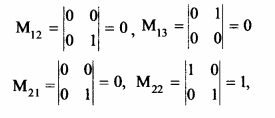
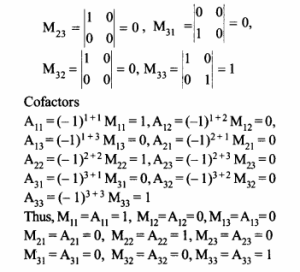
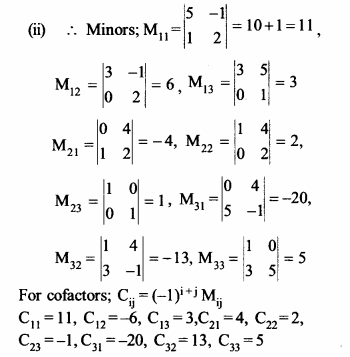
Ex 4.4 Class 12 Maths Question 3.
Using cofactors of elements of second row, evaluate
\(\Delta =\left| \begin{matrix} 5 & 3 & 8 \\ 2 & 0 & 1 \\ 1 & 2 & 3 \end{matrix} \right| \)
Solution.
Given
\(\Delta =\left| \begin{matrix} 5 & 3 & 8 \\ 2 & 0 & 1 \\ 1 & 2 & 3 \end{matrix} \right| \)
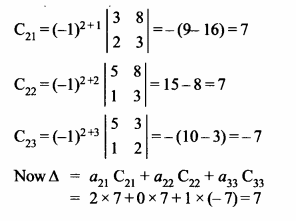
Ex 4.4 Class 12 Maths Question 4.
Using Cofactors of elements of third column, evaluate
\(\Delta =\left| \begin{matrix} 1 & x & yz \\ 1 & y & zx \\ 1 & z & xy \end{matrix} \right| \)
Solution.
Elements of third column are yz, zx, xy
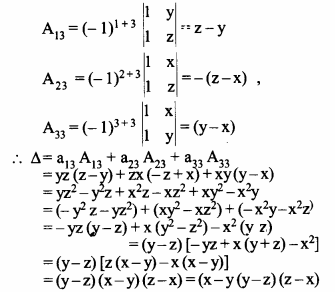
Ex 4.4 Class 12 Maths Question 5.
If \(\Delta =\left| \begin{matrix} { a }_{ 11 } & { a }_{ 12 } & { a }_{ 13 } \\ { a }_{ 21 } & { a }_{ 22 } & { a }_{ 23 } \\ { a }_{ 31 } & { a }_{ 32 } & { a }_{ 33 } \end{matrix} \right| \) and Aij is the cofactors of aij? then value of ∆ is given by
(a) a11A31+a12A32+a13A33
(b) a11A11+a12A21+a13A31
(c) a21A11+a22A12+a23A13
(d) a11A11+a21A21+a31A31
Solution.
Option (d) is correct.
NCERT Solutions for Class 12 Maths Chapter 4 Determinants Ex 4.5
Find the adjoint of each of the matrices in Questions 1 and 2.
<Ex 4.5 Class 12 Maths Question 1.
\(\begin{bmatrix} 1 & 2 \\ 3 & 4 \end{bmatrix}=A(say)\)
Solution.
Let Cij be cofactor of aij in A. Then, the cofactors of elements of A are given by
C11 = (-1)1+1 (4) = 4; C12 = (-1)1+2 (3) = -3
C21 = (-1)2+1 (2)= – 2; C22 = (-1)2+2 (1) = -1
Adj A = \(\begin{bmatrix} 4 & -3 \\ -2 & 1 \end{bmatrix}\)
= \(\begin{bmatrix} 4 & -2 \\ -3 & 1 \end{bmatrix}\)
Ex 4.5 Class 12 Maths Question 2.
\(\left[ \begin{matrix} 1 & -1 & 2 \\ 2 & 3 & 5 \\ -2 & 0 & 1 \end{matrix} \right] =A(say) \)
Solution.
\({ A }_{ 11 }={ (-1) }^{ 1+1 }M_{ 11 }=\begin{vmatrix} 3 & 5 \\ 0 & 1 \end{vmatrix}=3\)
Similarly,

Verify A (adjA) = (adjA) •A = |A| I in Qs. 3 and 4.
Ex 4.5 Class 12 Maths Question 3.
\(\begin{bmatrix} 2 & 3 \\ -4 & 6 \end{bmatrix}=A(say)\)
Solution.
|A| = 24
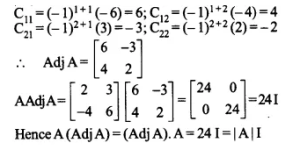
Ex 4.5 Class 12 Maths Question 4.
\(\left[ \begin{matrix} 1 & -1 & 2 \\ 3 & 0 & -2 \\ 1 & 0 & 3 \end{matrix} \right] =A(say)\)
Solution.
A11 = 0, A12 = – 11, A13 = 0,
A21 = – 3, A22 = 1, A23 = 1, A31 = – 2
A32 = 8, A33 = – 3
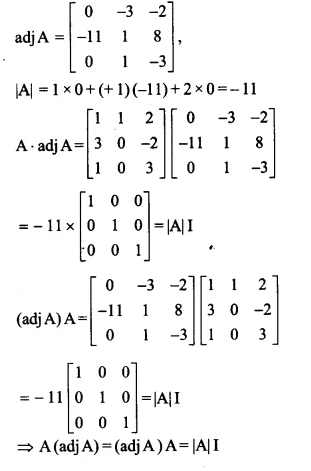
Find the inverse of each of the matrices (if it exists) given in Questions 5 to 11:
Ex 4.5 Class 12 Maths Question 5.
\(\begin{bmatrix} 2 & -2 \\ 4 & 3 \end{bmatrix}=A(say)\)
Solution.
\(\left| A \right| =\begin{vmatrix} 2 & -2 \\ 4 & 3 \end{vmatrix}=6+8=14\neq 0\)
So, A is a non-singular matrix and therefore it is invertible. Let cij be cofactor of aij in A. Then, the cofactors of elements of A are given by
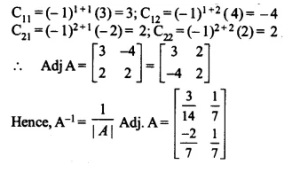
Ex 4.5 Class 12 Maths Question 6.
\(\begin{bmatrix} -1 & 5 \\ -3 & 2 \end{bmatrix}=A(say) \)
Solution.
\(\left| A \right| =\begin{vmatrix} -1 & 5 \\ -3 & 2 \end{vmatrix}=-2+15=13\neq 0 \)
So, A is a non-singular matrix and therefore it is invertible. Let cij be cofactor of aij in A. Then, the cofactors of elements of A are given by

Ex 4.5 Class 12 Maths Question 7.
\(\left[ \begin{matrix} 1 & 2 & 3 \\ 0 & 2 & 4 \\ 0 & 0 & 5 \end{matrix} \right] =A\)
Solution.
|A| = 10
\(\left[ \begin{matrix} 1 & 2 & 3 \\ 0 & 2 & 4 \\ 0 & 0 & 5 \end{matrix} \right] =A\)
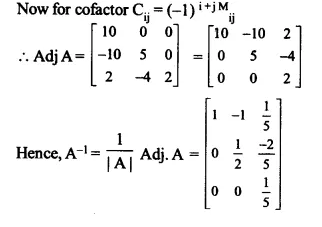
Ex 4.5 Class 12 Maths Question 8.
\(\left[ \begin{matrix} 1 & 0 & 0 \\ 3 & 3 & 0 \\ 5 & 2 & -1 \end{matrix} \right] =A\)
Solution.
\(\left| A \right| =\left| \begin{matrix} 1 & 0 & 0 \\ 3 & 3 & 0 \\ 5 & 2 & -1 \end{matrix} \right| =1\left| \begin{matrix} 3 & 0 \\ 2 & -1 \end{matrix} \right| =-3\neq 0\)
So, A is a non-singular matrix and therefore it is invertible. Let cij be cofactor of aij in A. Then, the cofactors of elements of A are given by
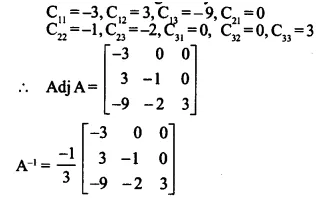
Ex 4.5 Class 12 Maths Question 9.
\(\left[ \begin{matrix} 2 & 1 & 3 \\ 4 & -1 & 0 \\ -7 & 2 & 1 \end{matrix} \right] =A\)
Solution.
|A| = \(\left[ \begin{matrix} 2 & 1 & 3 \\ 4 & -1 & 0 \\ -7 & 2 & 1 \end{matrix} \right] =A\)
= 2(-1-0)-1(4-0)+3(8-3)
So, A is non-singular matrix and therefore, it is invertible.

Ex 4.5 Class 12 Maths Question 10.
\(\left[ \begin{matrix} 1 & -1 & 2 \\ 0 & 2 & -3 \\ 3 & -2 & 4 \end{matrix} \right] =A\)
Solution.
|A| = \(\left[ \begin{matrix} 1 & -1 & 2 \\ 0 & 2 & -3 \\ 3 & -2 & 4 \end{matrix} \right] =A\)
= 1(8-6)+1(0+9)+2(0-6)
= 2+9-12
= -1≠0
∴A is invertible and
\({ A }^{ -1 }=\frac { Adj\quad A }{ |A| } \)
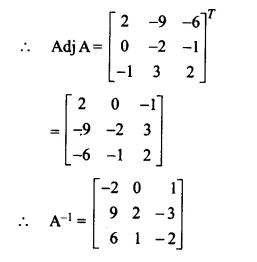
Ex 4.5 Class 12 Maths Question 11.
\(\left[ \begin{matrix} 1 & 0 & 0 \\ 0 & cos\alpha & sin\alpha \\ 0 & sin\alpha & -cos\alpha \end{matrix} \right] \)
Solution.
A = \(\left[ \begin{matrix} 1 & 0 & 0 \\ 0 & cos\alpha & sin\alpha \\ 0 & sin\alpha & -cos\alpha \end{matrix} \right] \)
adj A = \(\left[ \begin{matrix} -1 & 0 & 0 \\ 0 & -cos\alpha & -sin\alpha \\ 0 & -sin\alpha & cos\alpha \end{matrix} \right] \)
First find |A| = -cos²α-sin²α
=-1≠0

Ex 4.5 Class 12 Maths Question 12.
Let \(A=\begin{bmatrix} 3 & 7 \\ 2 & 5 \end{bmatrix},B=\begin{bmatrix} 6 & 8 \\ 7 & 9 \end{bmatrix}\), verify that (AB)-1 = B-1A-1
Solution.
Here |A| = \(A=\begin{bmatrix} 3 & 7 \\ 2 & 5 \end{bmatrix} \)
= 15-14
= 1≠0
\(Adj A=\begin{bmatrix} 5 & -7 \\ -2 & 3 \end{bmatrix} \)
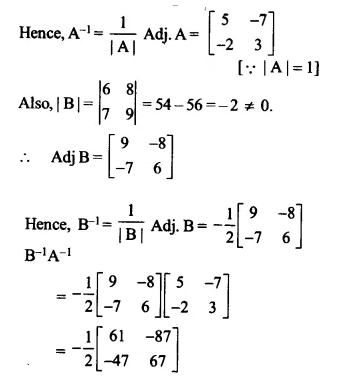
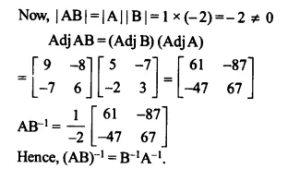
Ex 4.5 Class 12 Maths Question 13.
If \(A=\begin{bmatrix} 3 & 1 \\ -1 & 2 \end{bmatrix} \) show that A² – 5A + 7I = 0,hence find A-1
Solution.
A = \(\begin{bmatrix} 3 & 1 \\ -1 & 2 \end{bmatrix} \)
A² = \(\begin{bmatrix} 8 & 5 \\ -5 & 3 \end{bmatrix} \)

Ex 4.5 Class 12 Maths Question 14.
For the matrix A = \(\begin{bmatrix} 3 & 2 \\ 1 & 1 \end{bmatrix} \) find file numbers a and b such that A²+aA+bI²=0. Hence, find A-1.
Solution.
A = \(\begin{bmatrix} 3 & 2 \\ 1 & 1 \end{bmatrix} \)
A²+aA+bI²=0

Ex 4.5 Class 12 Maths Question 15.
For the matrix \(A=\left[ \begin{matrix} 1 & 1 & 1 \\ 1 & 2 & -3 \\ 2 & -1 & 3 \end{matrix} \right] \) Show that A³-6A²+5A+11I3=0.Hence find A-1
Solution.
A² = \( \left[ \begin{matrix} 4 & 2 & 1 \\ -3 & 8 & -14 \\ 7 & -3 & 14 \end{matrix} \right] \)


Ex 4.5 Class 12 Maths Question 16.
If \(A=\left[ \begin{matrix} 2 & -1 & 1 \\ -1 & 2 & -1 \\ 1 & -1 & 2 \end{matrix} \right] \) show that A³-6A²+9A-4I=0 and hence, find A-1
Solution.
We have
\(A=\left[ \begin{matrix} 2 & -1 & 1 \\ -1 & 2 & -1 \\ 1 & -1 & 2 \end{matrix} \right] \)


Ex 4.5 Class 12 Maths Question 17.
Let A be a non-singular square matrix of order 3×3. Then | Adj A | is equal to:
(a) | A |
(b) | A |²
(c) | A |³
(d) 3 | A |
Solution.
Let A = \(\left[ \begin{matrix} { a }_{ 11 } & { a }_{ 12 } & { a }_{ 13 } \\ { a }_{ 21 } & { a }_{ 22 } & { a }_{ 23 } \\ { a }_{ 31 } & { a }_{ 32 } & { a }_{ 33 } \end{matrix} \right] \)
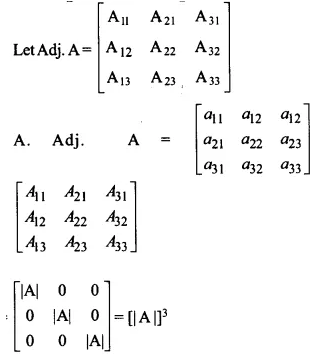
Dividing by | A |, |Adj. A| = | A |²
Hence, Part (b) is the correct answer.
Ex 4.5 Class 12 Maths Question 18.
If A is an invertible matrix of order 2, then det. (A-1) is equal to:
(a) det. (A)
(b) \(\\ \frac { 1 }{ det.(A) } \)
(c) 1
(d) 0
Solution.
|A|≠0
=> A-1 exists => AA-1 = I
|AA-1| = |I| = I
=> |A||A-1| = I
\(|{ A }^{ -1 }|=\frac { 1 }{ |A| } \)
Hence option (b) is correct.
NCERT Solutions for Class 12 Maths Chapter 4 Determinants Ex 4.6
Examine the consistency of the system of equations in Questions 1 to 6:
<Ex 4.6 Class 12 Maths Question 1.
x + 2y = 2
2x + 3y = 3
Solution.
x + 2y = 2,
2x + 3y = 3
=> \(\begin{bmatrix} 1 & 2 \\ 2 & 3 \end{bmatrix}\left[ \begin{matrix} x \\ y \end{matrix} \right] =\left[ \begin{matrix} 2 \\ 3 \end{matrix} \right] \)
=> AX = B
Now |A| = \(\begin{vmatrix} 1 & 2 \\ 2 & 3 \end{vmatrix}\)
= 3 – 4
= – 1 ≠ 0.
Hence, equations are consistent.
Ex 4.6 Class 12 Maths Question 2.
2x – y = 5
x + y = 4
Solution.
2x – y = 5,
x + y = 4
=> \(\begin{bmatrix} 2 & -1 \\ 1 & 1 \end{bmatrix}\left[ \begin{matrix} x \\ y \end{matrix} \right] =\left[ \begin{matrix} 5 \\ 4 \end{matrix} \right] \)
=> AX = B
Now |A| = \(\begin{vmatrix} 2 & -1 \\ 1 & 1 \end{vmatrix}\)
= 2 + 1
= 3 ≠ 0.
Hence, equations are consistent.
Ex 4.6 Class 12 Maths Question 3.
x + 3y = 5,
2x + 6y = 8
Solution.
x + 3y = 5,
2x + 6y = 8
=> \(\begin{bmatrix} 1 & 3 \\ 2 & 6 \end{bmatrix}\left[ \begin{matrix} x \\ y \end{matrix} \right] =\left[ \begin{matrix} 5 \\ 8 \end{matrix} \right] \)
=> AX = B
Now |A| = \(\begin{vmatrix} 1 & 3 \\ 2 & 6 \end{vmatrix}\)
= 6 – 6
= 0.
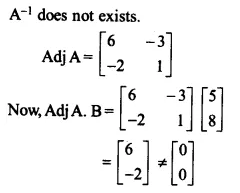
Hence, equations are consistent with no solution
Ex 4.6 Class 12 Maths Question 4.
x + y + z = 1
2x + 3y + 2z = 2
ax + ay + 2az = 4
Solution.
x + y + z = 1
2x + 3y + 2z = 2
x + y + z = \(\\ \frac { 4 }{ a } \)
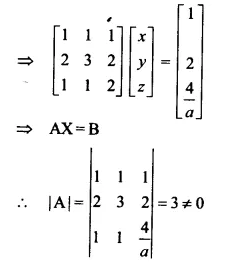
Ex 4.6 Class 12 Maths Question 5.
3x – y – 2z = 2
2y – z = – 1
3x – 5y = 3
Solution.
\(\left[ \begin{matrix} 3 & -1 & -2 \\ 0 & 2 & -1 \\ 3 & -5 & 0 \end{matrix} \right] \left[ \begin{matrix} x \\ y \\ z \end{matrix} \right] =\left[ \begin{matrix} 2 \\ -1 \\ 3 \end{matrix} \right] \)
=> AX = B
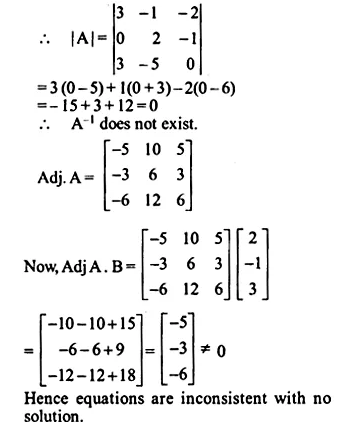
Ex 4.6 Class 12 Maths Question 6.
5x – y + 4z = 5
2x + 3y + 5z = 2
5x – 2y + 6z = -1
Solution.
Given
5x – y + 4z = 5
2x + 3y + 5z = 2
5x – 2y + 6z = -1
\(\left[ \begin{matrix} 5 & -1 & 4 \\ 2 & 3 & 5 \\ 5 & -2 & 6 \end{matrix} \right] \left[ \begin{matrix} x \\ y \\ z \end{matrix} \right] =\left[ \begin{matrix} 5 \\ 2 \\ -1 \end{matrix} \right] \)
\(AX=B|A|=\left[ \begin{matrix} 5 & -1 & 4 \\ 2 & 3 & 5 \\ 5 & -2 & 6 \end{matrix} \right] \)
= 5(18 + 10)+1(12 – 25)+4(-4-15)
= 140-13-76
= 51 ≠ 0
Hence equations are consistent with a unique
Solution.
Solve system of linear equations using matrix method in Questions 7 to 14:
Ex 4.6 Class 12 Maths Question 7.
5x + 2y = 4
7x + 3y = 5
Solution.
The given system of equations can be written as
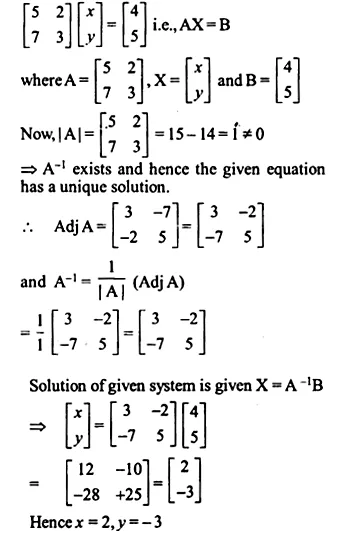
Ex 4.6 Class 12 Maths Question 8.
2x – y = – 2
3x + 3y = 3
Solution.
The given system of equations can be written
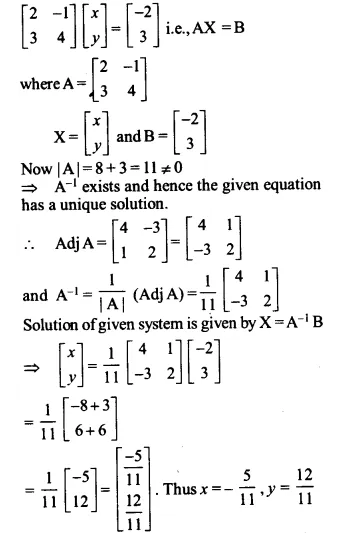
Ex 4.6 Class 12 Maths Question 9.
4x – 3y = 3
3x – 5y = 7
Solution.
The given system of equations can be written as
\(\begin{bmatrix} 4 & -3 \\ 3 & -5 \end{bmatrix}\left[ \begin{matrix} x \\ y \end{matrix} \right] =\left[ \begin{matrix} 3 \\ 7 \end{matrix} \right] i.e,,AX=B\)
where \(A=\begin{bmatrix} 4 & -3 \\ 3 & -5 \end{bmatrix}\)
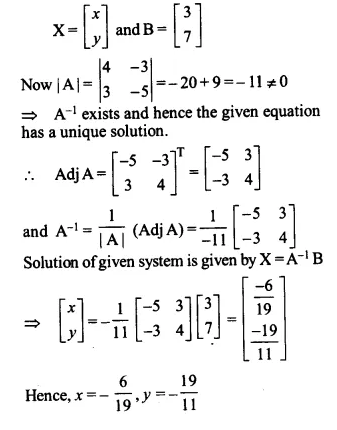
Ex 4.6 Class 12 Maths Question 10.
5x + 2y = 3
3x + 2y = 5
Solution.
The given system of equations can be written as
\(\begin{bmatrix} 5 & 2 \\ 3 & 2 \end{bmatrix}\left[ \begin{matrix} x \\ y \end{matrix} \right] =\left[ \begin{matrix} 3 \\ 5 \end{matrix} \right] i.e,,AX=B\)
where \(A=\begin{bmatrix} 5 & 2 \\ 3 & 2 \end{bmatrix}\)
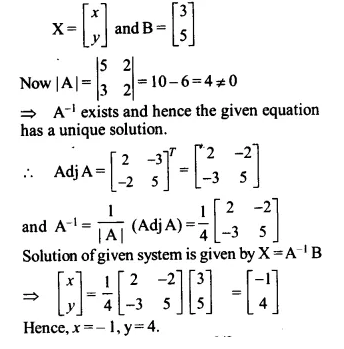
Ex 4.6 Class 12 Maths Question 11.
2x + y + z = 1,
x – 2y – z = 3/2
3y – 5z = 9
Solution.
The given system of equations are
2x + y + z = 1,
x – 2y – z = 3/2,
3y – 5z = 9
We know AX = B => X = A-1B
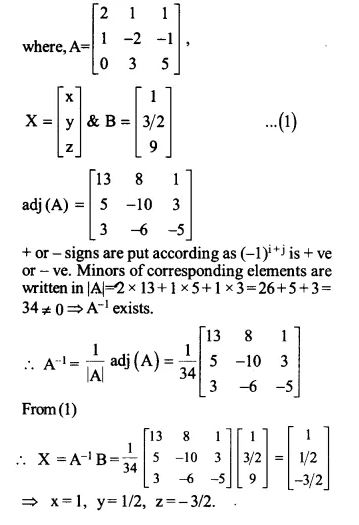
Ex 4.6 Class 12 Maths Question 12.
x – y + z = 4
2x + y – 3z = 0
x + y + z = 2.
Solution.
The given system of equations can be written
\(\left[ \begin{matrix} 1 & -1 & 1 \\ 2 & 1 & -3 \\ 1 & 1 & 1 \end{matrix} \right] \left[ \begin{matrix} x \\ y \\ z \end{matrix} \right] =\left[ \begin{matrix} 4 \\ 0 \\ 2 \end{matrix} \right] i.e,,AX=B\)
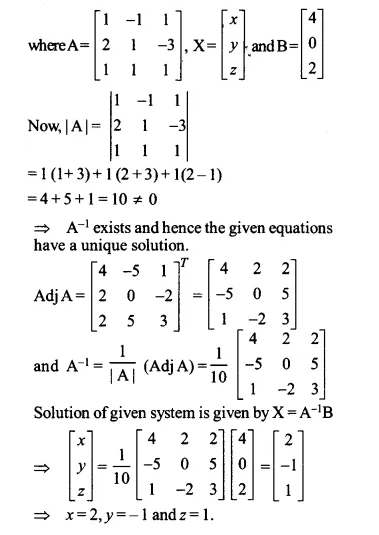
Ex 4.6 Class 12 Maths Question 13.
2x + 3y + 3z = 5
x – 2y + z = – 4
3x – y – 2z = 3
Solution.
The given system of equations can be written as:
\(\left[ \begin{matrix} 2 & 3 & 3 \\ 1 & -2 & 1 \\ 3 & -1 & -2 \end{matrix} \right] \left[ \begin{matrix} x \\ y \\ z \end{matrix} \right] =\left[ \begin{matrix} 5 \\ -4 \\ 3 \end{matrix} \right] i.e,,AX=B \)
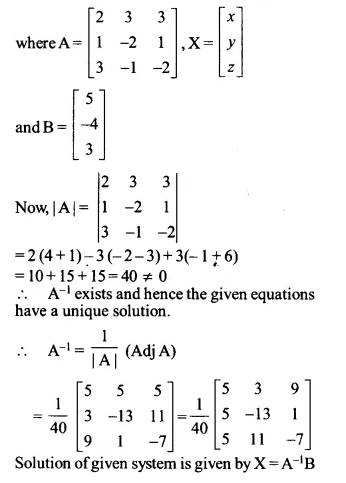
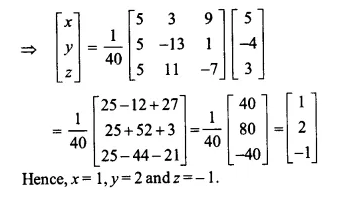
Ex 4.6 Class 12 Maths Question 14.
x – y + 2z = 7
3x + 4y – 5z = – 5
2x – y + 3z = 12.
Solution.
The given system of equations can be written
\(\left[ \begin{matrix} 1 & -1 & 2 \\ 3 & 4 & -5 \\ 2 & -1 & 3 \end{matrix} \right] \left[ \begin{matrix} x \\ y \\ z \end{matrix} \right] =\left[ \begin{matrix} 7 \\ -5 \\ 12 \end{matrix} \right] i.e,,AX=B \)
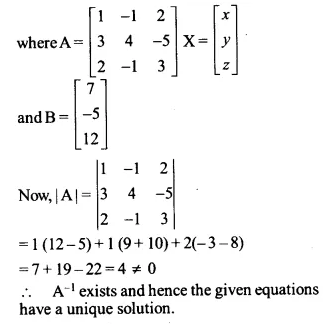
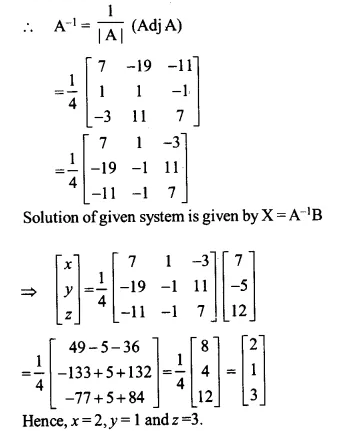
Ex 4.6 Class 12 Maths Question 15.
If A = \(\left[ \begin{matrix} 2 & -3 & 5 \\ 3 & 2 & -4 \\ 1 & 1 & -2 \end{matrix} \right] \) Find A-1. Using A-1. Solve the following system of linear equations 2x – 3y + 5z = 11,3x + 2y – 4z = – 5, x + y – 2z = – 3
Solution.
We have AX = B
where \(A=\left[ \begin{matrix} 2 & -3 & 5 \\ 3 & 2 & -4 \\ 1 & 1 & -2 \end{matrix} \right] ,X=\left[ \begin{matrix} x \\ y \\ z \end{matrix} \right] \)
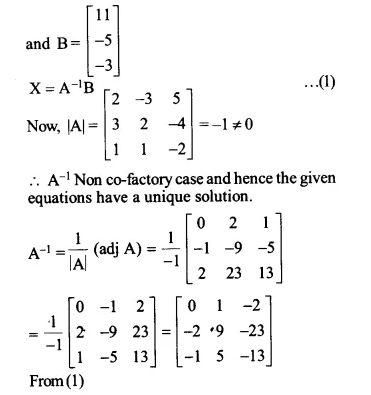
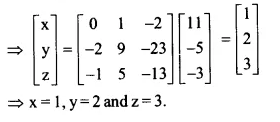
Ex 4.6 Class 12 Maths Question 16.
The cost of 4 kg onion, 3 kg wheat and 2 kg rice is Rs. 69. The cost of 2 kg onion, 4 kg wheat and 6 kg rice is Rs. 90. The cost of 6 kg onion, 2 kg wheat and 3 kg rice is Rs. 70. Find the cost of each item per kg by matrix method
Solution.
Let cost of 1 kg onion = Rs x
and cost of 1 kg wheat = Rs y
and cost of 1 kg rice = Rs z
4x+3y+2z=60
2x+4y+6z=90
6x+2y+3z=70
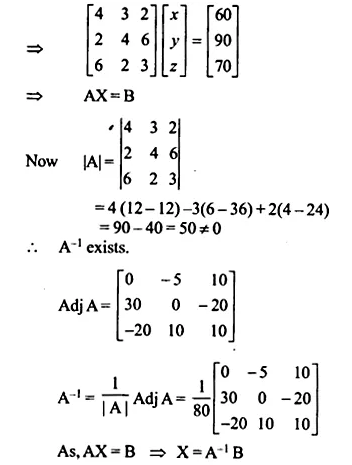
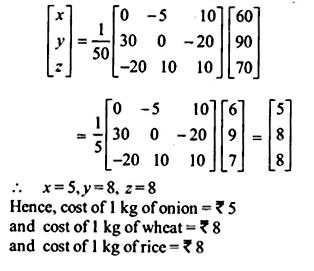
NCERT Class 12 Maths
Class 12 Maths Chapters | Maths Class 12 Chapter 4
Chapterwise NCERT Solutions for Class 12 Maths
-
NCERT Solutions For Class 12 Maths Chapter 1 Relations and Functions
NCERT Solutions For Class 12 Maths Chapter 2 Inverse Trigonometric Functions
NCERT Solutions For Class 12 Maths Chapter 3 Matrix
NCERT Solutions For Class 12 Maths Chapter 4 Determinants
NCERT Solutions For Class 12 Maths Chapter 5 Continuity and Differentiability
NCERT Solutions For Class 12 Maths Chapter 6 Application of Derivatives
NCERT Solutions For Class 12 Maths Chapter 7 Integrals
NCERT Solutions For Class 12 Maths Chapter 8 Application of Integrals
NCERT Solutions For Class 12 Maths Chapter 9 Differential Equations
NCERT Solutions For Class 12 Maths Chapter 10 Vector Algebra
NCERT Solutions For Class 12 Maths Chapter 11 Three-dimensional Geometry
NCERT Solutions For Class 12 Maths Chapter 12 Linear Programming
NCERT Solutions For Class 12 Maths Chapter 13 Probability
| NCERT Solutions for Class 12 All Subjects | NCERT Solutions for Class 10 All Subjects |
| NCERT Solutions for Class 11 All Subjects | NCERT Solutions for Class 9 All Subjects |

Post a Comment
इस पेज / वेबसाइट की त्रुटियों / गलतियों को यहाँ दर्ज कीजिये
(Errors/mistakes on this page/website enter here)